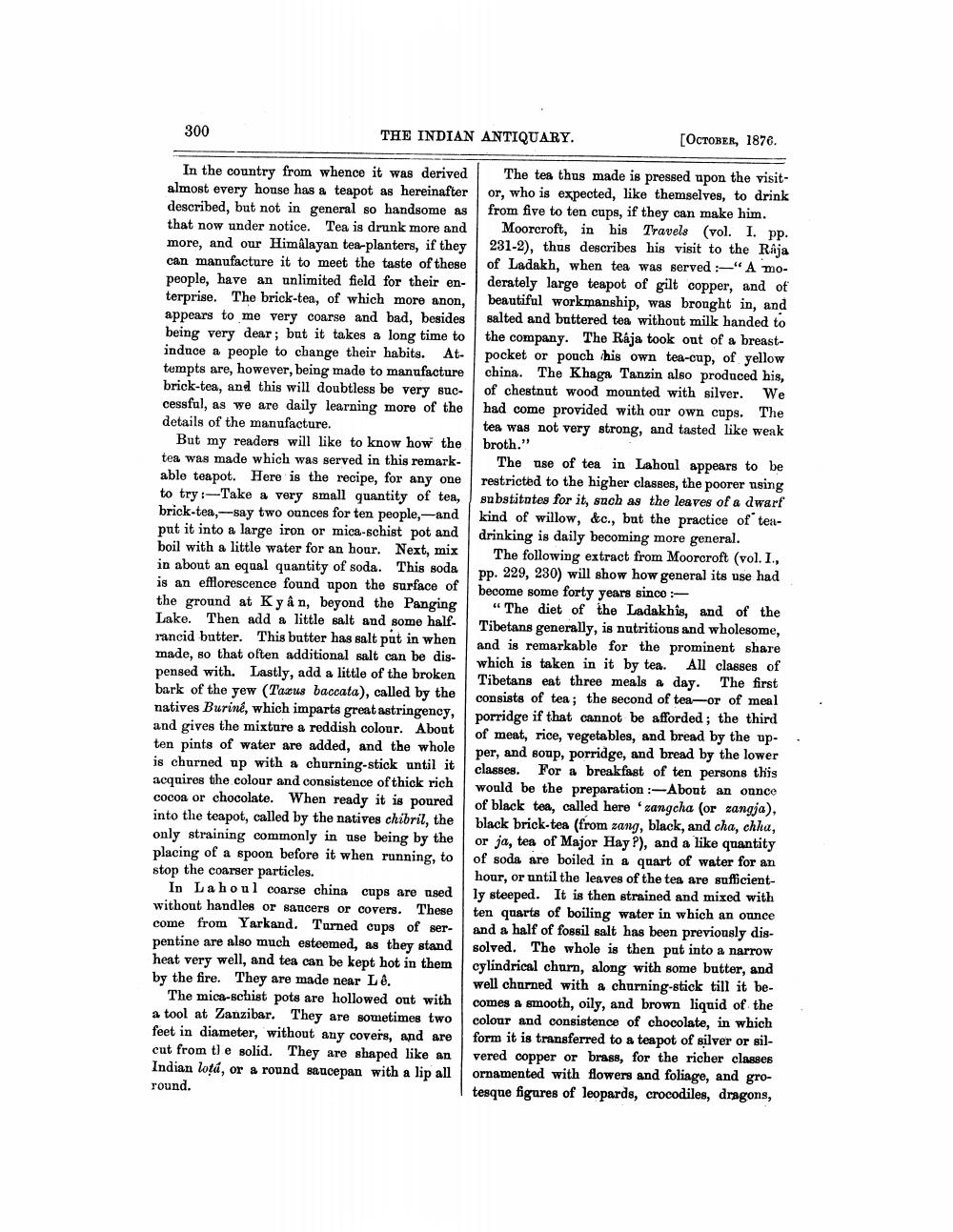________________
300
THE INDIAN ANTIQUARY.
[OCTOBER, 187e.
In the country from whence it was derived almost every house has a teapot as hereinafter described, but not in general so handsome as that now under notice. Tea is drunk more and more, and our Himalayan tea-planters, if they can manufacture it to meet the taste of these people, have an unlimited field for their en- terprise. The brick-tea, of which more anon, appears to me very coarse and bad, besides being very dear; but it takes a long time to induce a people to change their habits. Attempts are, however, being made to manufacture brick-tea, and this will doubtless be very successful, as we are daily learning more of the details of the manufacture.
But my readers will like to know how the tea was made which was served in this remarkable teapot. Here is the recipe, for any one to try :-Take a very small quantity of tea, brick-tea, --say two ounces for ten people, and put it into a large iron or mica-schist pot and boil with a little water for an hour. Next, mix in about an equal quantity of soda. This soda is an efflorescence found upon the surface of the ground at Kyân, beyond the Panging Lake. Then add a little salt and some halfrancid butter. This butter has salt put in when made, so that often additional salt can be dispensed with. Lastly, add a little of the broken bark of the yew (Taxus baccata), called by the natives Burine, which imparts great astringency, and gives the mixture a reddish colour. About ten pints of water are added, and the whole is churned up with a churning-stick until it acquires the colour and consistence of thick rich cocoa or chocolate. When ready it is poured into the teapot, called by the natives chibril, the only straining commonly in use being by the placing of a spoon before it when running, to stop the coarser particles.
In Lahoul coarse china cups are used without handles or saucers or covers. These come from Yarkand. Tarned cups of serpentine are also much esteemed, as they stand heat very well, and tea can be kept hot in them by the fire. They are made near Lê.
The mica-schist pots are hollowed out with a tool at Zanzibar. They are sometimes two feet in diameter, without any covers, and are cut from the solid. They are shaped like an Indian lotá, or a round saucepan with a lip all round.
The tea thus made is pressed upon the visitor, who is expected, like themselves, to drink from five to ten cups, if they can make him.
Moorcroft, in his Travels (vol. I. pp. 231-2), thus describes his visit to the Raja of Ladakh, when tea was served :-"A moderately large teapot of gilt copper, and of beautiful workmanship, was brought in, and salted and buttered tea without milk handed to the company. The Rája took out of a breastpocket or pouch his own tea-cup, of yellow china. The Khaga Tanzin also produced his, of chestnut wood mounted with silver. We had come provided with our own cups. The tea was not very strong, and tasted like weak broth."
The use of tea in Lahoul appears to be restricted to the higher classes, the poorer using substitutes for it, such as the leaves of a dwarf kind of willow, &c., but the practice of texdrinking is daily becoming more general.
The following extract from Moorcroft (vol. 1, pp. 229, 230) will show how general its use had become some forty years since -
"The diet of the Ladakhîs, and of the Tibetans generally, is nutritions and wholesome, and is remarkable for the prominent share which is taken in it by tea. All classes of Tibetans eat three meals a day. The first consists of tea; the second of tea-or of meal porridge if that cannot be afforded; the third of meat, rice, vegetables, and bread by the up. per, and soup, porridge, and bread by the lower classes. For a breakfast of ten persons this would be the preparation :- About an ounce of black tea, called here angcha (or zangja), black brick-tea (from zang, black, and cha, chha, or ja, tea of Major Hay?), and a like quantity of soda are boiled in a quart of water for an hour, or until the leaves of the tea are sufficiently steeped. It is then strained and mixed with ten quarts of boiling water in which an ounce and a half of fossil salt has been previously dissolved. The whole is then put into a narrow cylindrical churn, along with some butter, and well churned with a churning-stick till it becomes a smooth, oily, and brown liquid of the colour and consistence of chocolate, in which form it is transferred to a teapot of silver or silvered copper or brass, for the richer classes ornamented with flowers and foliage, and grotesque figures of leopards, crocodiles, dragons,




